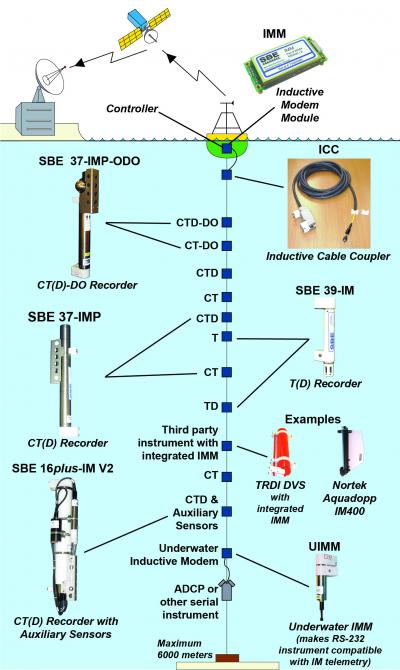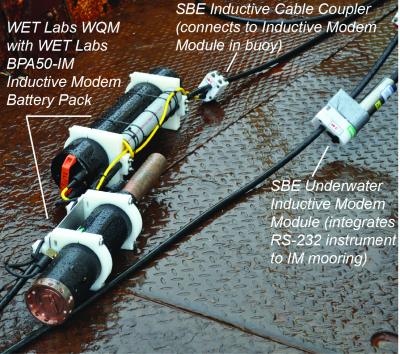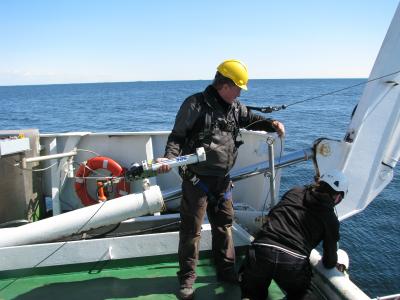- PRODUCTS
- MODEL LIST
- APPLICATIONS
- SUPPORT
- SALES/SERVICE
- BLOG
- ABOUT
Real-Time Ocean Observing Systems with Inductive Modem Telemetry Technology
As seen in Volume 20, Issue 8, August 2014

Authors Debbie Bresko, David Murphy, Sea-Bird Electronics
Real-time ocean observing systems provide critical information for the study of ecosystems, water quality, and fisheries, as well as data for long-term climate change studies. The development of satellite, RF, and cellphone telemetry has made real time, unattended, remote oceanography increasingly practical. However, before these telemetry techniques can be exploited, the data from underwater instruments must first be brought to the surface.
Traditional real-time moorings required breakouts for direct cable connections to instruments, with a potential for failure at each of the breakout locations. Furthermore, because the location and type of each instrument on a mooring line is fixed once the cable is manufactured, these systems lack the flexibility to adjust instrument locations and types once deployed. Real-time data from these systems could hint at interesting phenomena occurring between instruments on the mooring, but without the ability to reposition the instruments the details would not be captured. Utilizing an Inductive Modem (IM) system for the mooring provides reliable, real-time data transmission for up to 100 instruments that can be positioned or repositioned at any depth. IM moorings use standard plastic-jacketed wire rope as both the transmission line and mooring tension member. IM systems are more power-efficient than acoustic modems and offer reliable communication over greater distances.
The first Sea-Bird IM systems, utilizing SBE 37-IM MicroCAT CT and CTD instruments, were deployed in the western Pacific in 1998 by JAMSTEC (Japan Agency for Marine – Earth Science and Technology) for the Triton array. The Triton array is still in operation today and continues to use IM telemetry to deliver real-time data from sensors placed at depths up to 750 m on a 4,000-m mooring. The present buoy configuration includes 11 Sea-Bird MicroCAT CT and CTD instruments programmed to take a measurement every 10 minutes and report an hourly mean to the buoy controller via the IM system. More information on Triton is available at http://www.jamstec.go.jp/jamstec/TRITON/real_time/. More than 3,000 Sea-Bird IM instruments have been deployed worldwide in the ensuing 16 years.
Technical Details
An inductive modem uses electrical current loops to transmit information; current flowing in a wire loop induces current to flow in a loop that passes through it. In Sea-Bird’s IM system (Figure 1), the first loop is formed by the coupler connection of the surface buoy to the mooring cable. The second loop is formed by the mooring cable and the seawater; the cable is bare metal on the top and bottom and insulated in the middle. The third loop is at each underwater instrument. Because all coupling is done in loops, no cable breakouts are required. Each coupler is made up of two halves, allowing it to clamp around the cable, so the cable does not need to be threaded through the unit. For typical saltwater applications, the maximum transmission length is approximately 6,000 m. In fresh water, with its lower conductivity, good communications can be obtained over 1,000 m with conductivity as low as 100 microSiemens/cm.

Figure 1. Schematic of an IM system.
The IM system supports both autonomously operating instruments and those that require a command to take a measurement and return the data. The communications link is one way, meaning that if the surface modem is transmitting to the instruments, then the instruments must all be listening. Conversely, if one of the instruments is transmitting, then the surface modem must be listening. Global commands to take and store a measurement can be sent to all instruments on the mooring line. Each IM instrument is pre-programmed with an ID; data are acquired by sending a command to the individual instrument to transmit its data to the buoy controller.
The IM system can accommodate a wide variety of instruments for nearly any type of measurement. Sea-Bird manufactures IM versions of a number of instruments, measuring various combinations of temperature, conductivity, pressure, dissolved oxygen, and data from integrated auxiliary sensors (Figure 2). Also available is an Underwater Inductive Modem Module (UIMM) that allows instruments from other manufacturers to be integrated with an IM system; the UIMM includes electronics for buffering and storing data and a built-in inductive cable coupler and cable clamp; an RS-232 serial output instrument simply plugs into the UIMM end cap. An Inductive Modem Module (IMM) and a cable coupler can also be integrated in RS-232 serial output instruments at the development stage.

Figure 2. SBE 16plus-IM V2 SeaCAT CTD integrated
with SBE 63 Optical Dissolved Oxygen Sensor
Recent Field Experience
Sea-Bird’s IM system was recently used in dredge monitoring for the Fehmarn Belt Fixed Link project (Figure 3). Anders Jensen, business area manager for survey and monitoring for DHI, stated, “We built our buoy systems for the Fehmarn Belt Fixed Link project with WET Labs WQMs and Sea-Bird Inductive Modem technology, with great success...As a full-service provider of marine environmental-monitoring systems, DHI expects and our clients demand reliability. We build our buoys to provide this with near real-time delivery of data to the web and data redundancy in the instruments on the buoy as back up. DHI’s Aquaguard controller communicates with the instruments using Sea-Bird’s Inductive Modem technology, which has been the key to providing robust communication capability. Data transmission from the monitoring site assures our clients that their monitoring program is meeting their specifications and saves time and effort for everyone by reducing servicing trips.”

Figure 3. Inductive Mooring line, before deployment for Fehmarn
Belt Fixed Link Project (photo by DHI).
The Finnish Meteorological Institute (FMI) deployed an IM system in the Baltic Sea near Utö Island (Figure 4). Tero Purokoski of FMI stated, “Oceanographic measurements at the Utö ( http://en.ilmatieteenlaitos.fi/uto) have been conducted since 1900. Traditionally, the data has been used for monitoring climate change and variability in the Baltic Sea, but now the Station is also part of the European Integrated Carbon Observation System (ICOS). One of the science questions examines the role of the ocean physical processes on atmosphere-ocean gas exchanges. The data is also assimilated into operational oceanography models, improving our forecasting skill for the Baltic Sea.”

Figure 4. Deployment of SBE 37-IMP-ODOs on IM mooring in Baltic Sea
for Finnish Meteorological Institute (photo by Heini Jalli, FMI).
FMI’s system consists of a surface buoy with SST sensor, GPS, controller, and Iridium satellite connection. Underwater are SBE 37-IMP CT (4), SBE 37-IMP CTD (1), and SBE 37-IMP-ODO CTD with integrated optical dissolved oxygen (2) instruments. The CT and CTD instruments take a measurement every 5 minutes, the CTD-DO instruments take a measurement every 30 minutes, and the controller queries for data from the last measurement every 30 minutes. The surface buoy has enough battery power to operate for 12 months of uninterrupted data collection.
Summary
Real-time observing systems provide vital data for analyzing the ocean and inland waters. Inductive Modem systems provide reliable, flexible, low-cost, real-time data transmission for a wide variety of underwater instruments, including most RS-232 output instruments. For more information on IM systems, please see Application Note 92.

